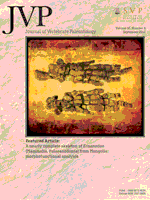An exquisitely preserved skull of Feeserpeton oklahomensis, gen. et sp. nov., collected from the Lower Permian fissure-fill deposits near Richards Spur, Oklahoma, is the newest parareptile from the locality. The specimen comprises an almost complete skull, lacking most of the premaxillae, parts of the jugals, and parts of the braincase. The maxillae and dentaries possess caniniform regions, including large caniniform teeth that are at least twice as large as any other tooth in the jaws. A phylogenetic analysis of Parareptilia that includes the new taxon indicates that the Early Permian F. oklahomensis is a member of the poorly known Lanthanosuchoidea, positioning it as the sister taxon of a clade consisting of Acleistorhinus pteroticus and Lanthanosuchus watsoni. This new taxon adds significantly to our limited knowledge of the early stages of parareptile evolution, as well as the large terrestrial tetrapod diversity found at Richards Spur.
How to translate text using browser tools
1 September 2012
A New Parareptile (Parareptilia, Lanthanosuchoidea) from the Early Permian of Oklahoma
Mark J. Macdougall,
Robert Reisz
ACCESS THE FULL ARTICLE





